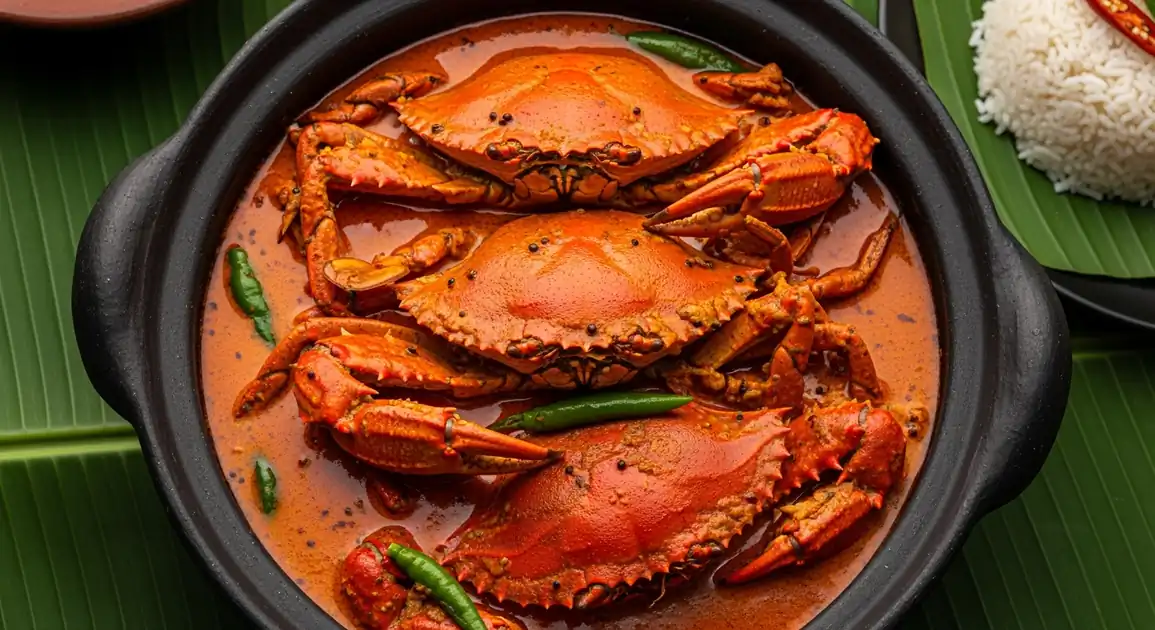Jaffna Crab Curry
யாழ்ப்பாண நண்டு கறி (Yāḻppāṇa Naṇṭu Kaṟi)

Description
Across Sri Lanka, Jaffna Crab Curry is recognized as a premier specialty dish, though its preparation varies by region. Northern provinces maintain the most authentic versions, while coastal regions may incorporate local adaptations. The dish represents the rich Tamil culinary heritage and has become a must-try specialty for visitors throughout the country.
Dietary Information
Serving information
Serving style
Traditionally served in a clay pot or bowl with steamed rice, accompanied by coconut sambol and occasionally other vegetable side dishes. Finger bowls with water and lemon are provided as this is eaten by hand. Crab crackers or small hammers may be offered for breaking shells.
Quick facts
Seafood restaurants typically operate from 11 AM - 11 PM, with peak hours from 7 PM - 9 PM for dinner.
Safety Tips
What to Look For
-
Live crabs in tanks or very fresh seafood displays
The quality and safety of crab curry depends primarily on the freshness of the crabs. Restaurants with aquarium tanks or clear displays of iced fresh seafood typically use better quality ingredients.
-
High turnover of customers, especially locals
Busy restaurants serving many customers, particularly locals, usually have fresher ingredients and better food safety practices.
-
Clean kitchen areas if visible
If you can glimpse the kitchen, check for general cleanliness and proper food handling practices.
-
Proper storage practices for seafood
Fresh seafood should be stored on ice or in refrigerated displays, not at room temperature.
What to avoid
-
Strong ammonia or overly fishy smell
Fresh crab should smell mildly of the sea. A strong ammonia or overly fishy odor indicates spoilage.
-
Crab meat with yellowish discoloration
Fresh crab meat should be white to off-white. Yellowish coloration may indicate older crabs or improper storage.
-
Pre-cooked curry reheated for service
Quality Jaffna Crab Curry should be prepared fresh. Ask if the curry is made to order, especially in less busy establishments.
-
Restaurants with very few customers and seafood on the menu
Seafood requires quick turnover to maintain freshness. Empty seafood restaurants might use older ingredients.
Price information
Price range
Budget tips
- Local 'rice and curry' spots with crab curry as a special may offer it for 1500-2500 LKR.
- Mid-range restaurants typically charge 2500-4000 LKR for a full portion.
- Specialized seafood restaurants, especially in tourist areas, may charge 4000-6000+ LKR.
- Consider ordering a full crab curry to share among 2-3 people to reduce per-person cost.
- Some restaurants price by weight - check if the quoted price is per 100g or for a full portion.
Value indicators
- Size and number of crabs in your serving.
- Freshness indicated by sweet smell and firm meat.
- Proper cooking shown by meat easily separating from shell.
- Complexity of the curry flavor beyond just heat.
- Generous portion of gravy to enjoy with rice.
Where to Find This Dish
Coastal Areas
Coastal towns and cities naturally have the freshest seafood and often the most authentic crab curry preparations.
Beach restaurants, Fisherman's harbors, Seafood markets
Evening
Tamil Areas
Areas with significant Tamil populations tend to maintain more authentic Jaffna-style preparations.
Tamil temples, Northern province towns
Lunch, Dinner
Tourist Centers
Major tourist destinations offer crab curry at varying levels of authenticity and spice levels.
Major hotels, Tourist restaurant strips
Dinner
Vendor Tips
- Ask about the crab source - lagoon crabs are traditionally preferred for this dish.
- Check if they prepare the curry fresh or if it's pre-made.
- Request your preferred spice level, as authentic versions are quite hot.
- Inquire about when their seafood delivery arrives - restaurants receiving morning deliveries often have the freshest crab.
How to Order
Regional Variations
-
Lagoon Crab Curry
(Kaḻi Naṇṭu Kaṟi)
The most traditional version using mud crabs from Jaffna's lagoons, known for their sweet meat. Generally smaller than sea crabs but considered superior in flavor for this dish.
-
Sea Crab Curry
(Kaṭal Naṇṭu Kaṟi)
A variation using larger ocean crabs, often with meatier claws. Common in Colombo restaurants and slightly less traditional but still delicious.
-
Ambulthiyal Crab
(Ambulthiyal Naṇṭu)
A southern coastal variation incorporating goraka (gamboge) for a sour taste alongside the spice. Less common but found in some fusion restaurants.
-
Crab Curry with Drumstick Leaves
(Muruṅkaikkīrai Naṇṭu Kaṟi)
A nutritious variation adding murunga (moringa) leaves to the curry, adding a distinct flavor and additional nutrition.
-
Coconut Milk Crab Curry
(Tēṅkāy Pāl Naṇṭu Kaṟi)
A creamier version using more coconut milk than traditional Jaffna style, popular in tourist areas and restaurants catering to milder palates.
Cultural context
History
This dish originates from Jaffna, the cultural capital of Sri Lanka's Tamil population in the northern peninsula. The recipe evolved from the abundant lagoon crab available in the region and the distinctive Tamil spice culture that developed separately from southern Sri Lankan cuisine. Historically, Tamil households would prepare this special dish for celebrations and important gatherings. During Sri Lanka's civil conflict, many Jaffna Tamils migrated to Colombo and other areas, bringing this culinary tradition to wider attention, ultimately establishing it as one of Sri Lanka's most celebrated seafood dishes internationally.
Local significance
Jaffna Crab Curry represents the distinct culinary identity of Sri Lanka's Tamil population and has become a source of national culinary pride internationally.
Eating customs
- Remove jewelry before eating, as the curry can stain.
- Use your right hand for eating, following Sri Lankan custom.
- Expect and embrace the messiness - getting curry on your hands is part of the experience.
- Take your time - crab curry is meant to be enjoyed slowly, extracting meat from each section.